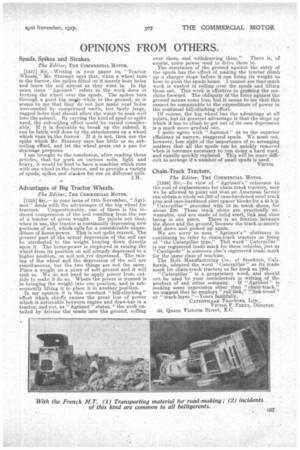OPINIONS FROM OTHERS.
Page 21

If you've noticed an error in this article please click here to report it so we can fix it.
Spuds, Spikes and Strakes.
The Editor, THE COMMERCIAL MOTOR.
[1557] Sir,---Writing in your paper on. "Tractor Wheels," Mr. Sturmey says that, when a wheel runs in the furrow, the spikes fitted on it merely bore holes and leave the soil almost as they went in. In the same issue " Agrirnot" refers to the work done m turning the wheel over the spuds.. The spikes turn through a good big amble while in the ground, so it seems to me that they do not just make neat holes surrounded by compressed earth, but fairly, large, ragged holes that should allow the water to soak well into the rjubsoil. By varying the kind of spud or spike used, the sub-soiling effect could be varied considerably. If it is desirable to break up the subsoil, it can be fairly well done by the attachments on a wheel which runs in. the furrow. If it is not, then use the spike which Mr. Sturmey says has little or no subsoiling effect, and let the wheel press out a pan for drainage purposes. I am brought to the conclusion, after reading these articles, that for work on various soils, light and heavy, it would be-test to have a machine which runs with one wheel in the furrow' and to provide a variety of spuds, spikes and stakes for use on different soils.
J.H.
Advantages of Big Tractor Wheels.
The Editer, THE COMMERCIAL MOTOR.
[1558] Sir,— in your issue of 15th November, " Agrimot " deals with the advantages of the big wheel for tractors. Unquestionably, one. of these is the reduced compression of the soil resulting from the use of a tractor of given -weight. He points out that, when in use, the tractor is continually depressing new portions of soil, which, calls for a considerable expenditure of horse-power. This is not quite correct The greater part of the actual depression of the soil can be attributed to the weight bearing down directly upon it. The horse-power is employed in raising the wheel from its position on soil already depressed to a higher position, on soil not yet depressed. The raising of the wheel and the depression of the soil are simultaneous, but the two things are not the same. Place a weight on a piece of soft ground and it will sink in. We do not need to apply power from outside to make it do so. Where the power is wanted is in bringing the weight into one position, and in subsequently lifting it to place it in another position.
In my opinion it is this constant " effort which chiefly causes the great km of power which is noticeable between engine and draw-bar in a tractor, and not, as" Agrimot ' states, "the work entailed by driving the spuds into the ground, 'rolling over them, and withdrawing them." There is, of course, some power used to drive them in.
The resistance of the ground against the entry of the spuds has the effect of making the tractor climb up a sharper slope before it can bring its weight to bear to push the spuds home. I cannot see that. much work is wasted in rolling over the spuds and lifting them out. This work is effective in pressing the machine forward. The obliquity cSf the force against the ground means some loss, but it seems to me that this cannot be comparable to the expenditure of power in
the continual hill-climbing effort. •
Of course, the big wheel has the advantage at all points, but its greatest advantage is that the slope up which it has to climb to get out of its own depression is a much more gradual one.
I quite agree with " Agrimot " as to the superior efficiency of narrow, staggered spuds. We must not, however, lose sight of the importance of so arranging matters that all the spuds can be quickly removed 'when it becomes necessary to run along a hard road, and equally quickly replaced. This will be more difficult to arrange if a number of small spuds is used. • VECTIS.
Chain,Track Tractors.
The Editor, THE COMMERCIAL MOTOR.
[15593 Sir,—In view of " Agrimot's " reference to the cost of replacements for chain-track tractors, may we be allowed to point out that an American farmer can obtain a. whole set (50) of case-hardened steel track pins and case-hardened steel spacer blocks or a 45 h.p. " Caterpillar " provided with 13 in track shoes, for about 220. These track shoes are practically unwearable, and are made of solid steel,. link and shoe being in one piece. There is no friction between the shoes and the ground, because the track_is merely laid down and picked up again.
We are sorry to note " Agrinaot's " obstinacy in continuing to refer to chain-track tractors as being of "the Caterpillar type." Thii word " Caterpillar" is our registered trade mark for these vehicles, just as " Centipede " is someone else's registered trade mark for the same class of machine.
The Holt Manufacturing Co., of Stockton, California, adopted the word " Caterpillar" as its trade mark for chain-track tractors as far back as 1904.
" Caterpillar " is a, proprietary word, and should not be used by your contributors in writing of the product of any other company. If " Agri/not " is seeking some expression other than "chain-track," we suggest that he employs "rail-link," "link-tread" or "track-layer."—Yours faithfully, CATERPILLAR TRACTORS, LTD.,
VICTOR F. FEENY, -Director. 00, Queen Victoria Street, E.C.
























